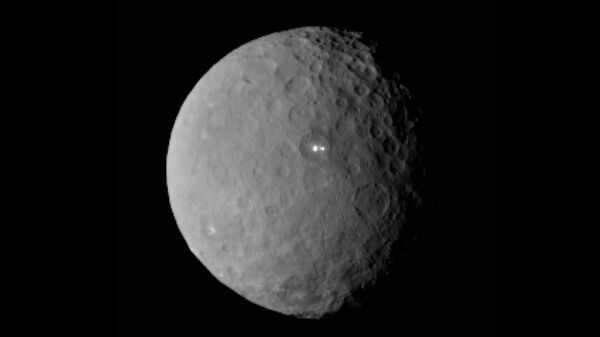The new photos released by Nasa show that a bright spot detected in previous images is actually two different flashes, named feature one and feature five.
The new infrared images were taken by Dawn from a distance of about 28,000 miles (45,000 km) and reveal that the two features have different thermal properties. The images revealed the varying materials that make up the dwarf planet's surface and different processes that created its features.
— NASA's Dawn Mission (@NASA_Dawn) April 13, 2015
"This dwarf planet was not just an inert rock throughout its history. It was active, with processes that resulted in different materials in different regions. We are beginning to capture that diversity in our color images," said Chris Russell, principal investigator for the Dawn mission, based at the University of California, Los Angeles.
— Dwarf Planet Ceres (@CeresToday) April 14, 2015
In the photos above, the top row are images of feature one at visible, infrared and thermal light. The bottom are of feature five. In thermal light, feature one appears as a dark spot, meaning it is cooler than it's surroundings, this is not the case for feature five.
"Spot number five shows no distinct thermal behaviour," said Federico Tosi, who works on Dawn's Visible and Infrared Spectrometer, at a news conference Monday.
That may be because of a difference in structure or in the materials it is made of.
Scientists will know more after Dawn is able to take better photos and begins its first intensive science phase on April 23, from a distance of 8,400 miles (13,500km) from the surface, said Martin Hoffmann, an investigator on Dawn's camera team.
One previous theory of the bright spots had been that they patches of ice covered by only a thin layer of dirt which form "cryovolcanos," spewing up water an ice from within the planet. Scientists think the core of Ceres is composed of ice and water.
Others had speculated that they spots were icy patches reflecting sunlight, or giving off a plume of vapor as it heats up. This would be consistent with changes in the brightness of the spots with exposure to sunlight.
The spots are also visible in the new images even when at the very edge of the line of sight, indicating that they are high up on the surface, not low in the bottom of the crater as previously thought.
— DLR — English (@DLR_en) April 8, 2015
The Dawn spacecraft launched in 2007 and started orbiting Ceres — which is the largest object in the asteroid belt between Mars and Jupiter — on March 6. Previously Dawn had been in orbit around Vesta — a large asteroid, and second largest object next to Ceres in that same belt — where it completed a 14 month mission.
Dawn will remain in orbit around Ceres perpetually after it's current mission is finished.


